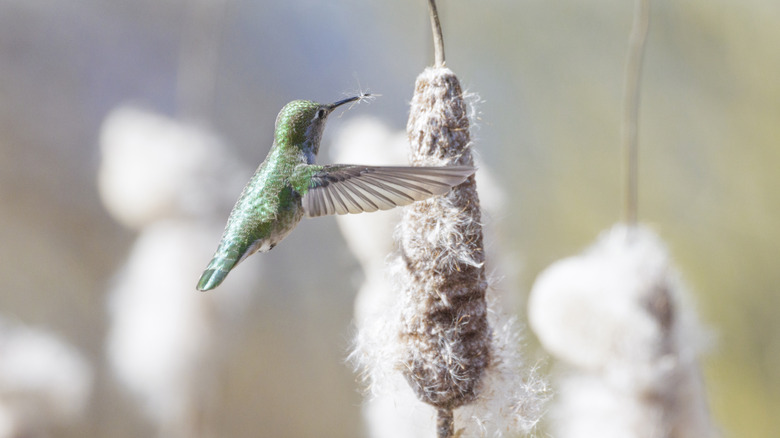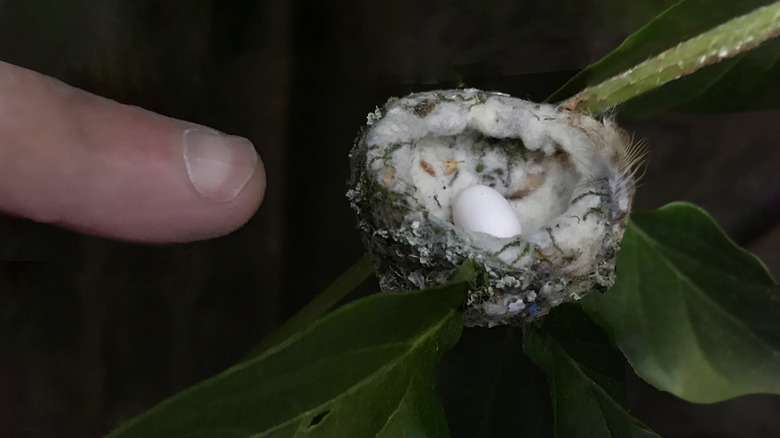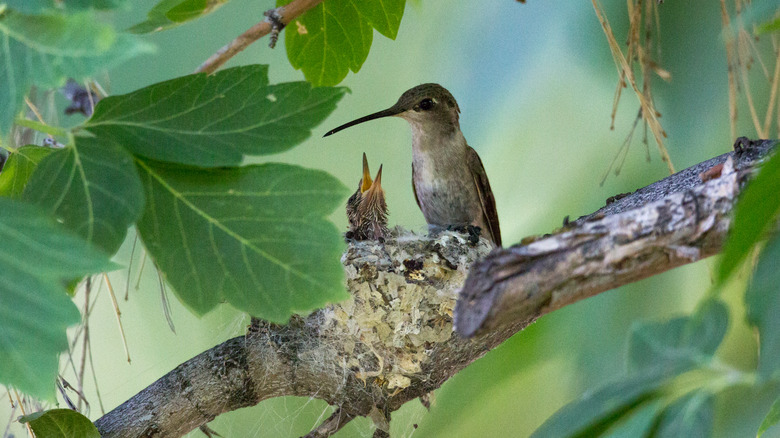Why Baby Hummingbirds Are So Hard To Spot (& What They Look Like)
Getting a glimpse of a baby bird can be one of life's little joys, especially if you've had your eye on a nesting mama as she's been prepping a home for her little family. It's not uncommon to spot a variety of birds nesting in the trees and shrubs on your property, but you might be wondering why you've never discovered a hummingbird's nest in the hope of spying some hatchlings. The main reason is the easily overlooked size, which like a hummingbird, is very small. The other issue is that hummingbirds place their well-camouflaged nests in different spots than other birds.
If you have a feeder frequented by these nectar-seeking visitors, you might also wonder why hummingbirds aren't using your birdhouse. The simple answer is that birdhouses don't fit the needs of nesting hummers. Although some ruby-throated hummingbirds have been known to use items like hanging planters for nesting sites in urban areas, most species tend to flock to certain nest-building plants and trees. Tree types include mulberry, willow, cottonwood, and poplar, to name a few. The nests are also built anywhere from 10 to 90 feet off the ground in many instances. If you do locate one and keep an eye on it with binoculars, you might find the babies look a lot like other birds when they're newly hatched — only much smaller.
More on hummingbird nests
When attempting to spot a hummingbird nest, look for small tree knots. Yes, they're usually placed on skinnier-than-average tree branches and well-hidden so they can indeed be mistaken for tree knots when birds are not in the nests. The size–generally about 1 inch in diameter — can vary a bit according to the species of hummingbird building the nest. Since their eggs are about the size of a navy bean, that's all the space a female hummer needs to hatch them.
As hummingbird babies grow, the nest expands with them. That is, the mother bird builds it out of flexible materials so that it expands as her hatchlings mature into fledglings. She employs a base including leaves and small twigs and finishing elements that include mossy materials that add a touch of camo to the outside. The magic element providing flexibility, however, is spider silk. A hummingbird can spend hours every day gathering spider silk to line a nest, tucking it into every cranny. If you spot a hummingbird coming and going from the same tree over and over, it could very well be nesting there.
Once you happen to locate one, this might make you wonder if hummingbirds will reuse the nest made in your yard. The answer is no. Once growing hummingbirds stretch them out, they won't be reused. When the mother bird nests again, she'll repeat the entire process all over.
What a baby hummingbird looks like
Hummingbird nestlings are born largely without feathers, so they rely on their mothers to not only nourish them but to keep them warm. They're so tiny, weighing less than 1 gram, that they fit inside the nest with room to spare. Their feet are so small that they can't stand until they grow a bit, and they won't fully develop their feathers for another three weeks. If you're watching the progress of a hummingbird brood at a distance, you probably won't even see them until they grow enough for their heads to extend above the nest during feeding.
Long beaks are a characterizing feature of adult hummingbirds, but hatchlings have beaks that are initially short. This makes them look like smaller versions of other types of baby birds as they're growing for the first week or so. By the time they leave the nest as fledglings, however, they'll develop long beaks that will allow them to feed on insects and drink nectar from flowers and feeders just like their mothers. So, even though you might have to search for these hard-to-spot nests in the trees around your yard and use binoculars to see them, the effort can be worth the reward.


